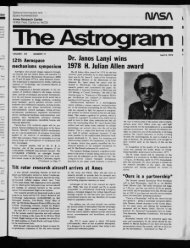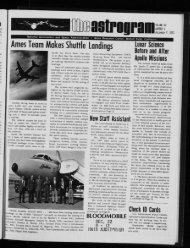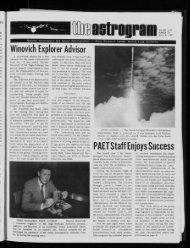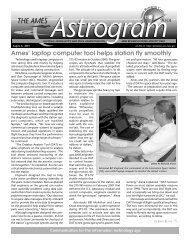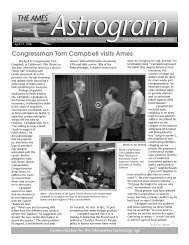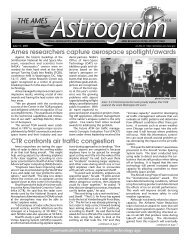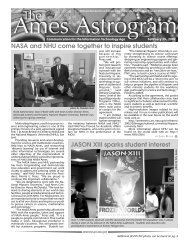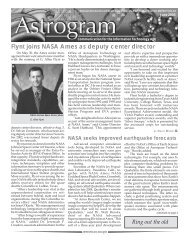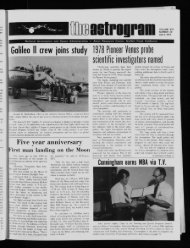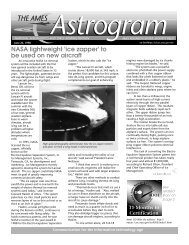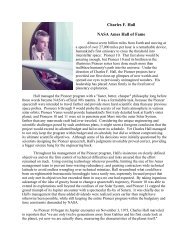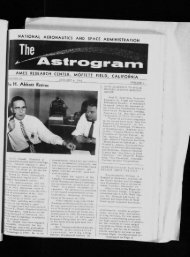Innovative partnership to revolutionize NASA supercomputing
Innovative partnership to revolutionize NASA supercomputing
Innovative partnership to revolutionize NASA supercomputing
You also want an ePaper? Increase the reach of your titles
YUMPU automatically turns print PDFs into web optimized ePapers that Google loves.
Supercomputing contribution recognized through TGIR award<br />
Guru P. Guruswamy of Code INA<br />
was part of the Abrupt Wing Stall (AWS)<br />
group that received a ‘Turning Goals<br />
Guru Guruswamy, winner of the Turning<br />
Goals in<strong>to</strong> Reality (TGIR) 2004 award.<br />
in<strong>to</strong> Reality (TGIR) 2004’ award presented<br />
during a ceremony at <strong>NASA</strong><br />
Headquarters in July. The AWS team<br />
was comprised of members from <strong>NASA</strong><br />
Langley and <strong>NASA</strong> Ames, the Naval<br />
Warfare Center, the Airforce Academy,<br />
Boeing and Lockheed Martin. The citation<br />
on the award states "2004 Partnership<br />
award for Exceptional Progress <strong>to</strong>ward<br />
the Partnerships for National Security<br />
Objective presented on July 14,<br />
2004 <strong>to</strong> the Abrupt Wing Stall (AWS)<br />
Team." Associate Administra<strong>to</strong>r of the<br />
Aerospace Enterprise Vic Lebacqz presented<br />
the award on behalf of <strong>NASA</strong><br />
Administra<strong>to</strong>r Sean O'Keefe.<br />
As part of the AWS team,<br />
Guruswamy led the numerical simulation<br />
effort of AWS phenomenon for an<br />
F18E/F aircraft in collaboration with<br />
David Rodriguez (former <strong>NASA</strong> Advanced<br />
Supercomputing (NAS) division<br />
support service contrac<strong>to</strong>r) and Professor<br />
Max Platzer of the Naval Post Graduate<br />
School. The flow phenomenon of<br />
wing stall was accurately and successfully<br />
simulated on a supercomputer at<br />
the NAS facility by using HiMAP software<br />
(winner of the <strong>NASA</strong> 2002 Software<br />
Release Award).<br />
Richard Madison, former Ames engineer, dies<br />
Richard Madison died suddenly on<br />
July 3 after two months convalescing<br />
from heart valve replacement.<br />
Madison was born in San Jose on<br />
July 27, 1925. He and his two brothers<br />
were raised on a pear ranch living<br />
Richard C. Madison<br />
through the great depression. After<br />
graduating from high school, he set his<br />
sights on an engineering degree and<br />
graduated in 1949 with a B.S. degree in<br />
mechanical engineering with honors<br />
from the University of California at Berkeley.<br />
After graduation, Madison began<br />
his 30-year career at <strong>NASA</strong> Ames. He<br />
was an early member of the design team<br />
for the unitary plan windtunnel system.<br />
Once the tunnels became operational he<br />
became a project engineer contributing<br />
notably <strong>to</strong> the testing of the F-111 Aardvark.<br />
The Unitary Tunnels provided<br />
aerodynamic testing for a myriad of famous<br />
military aircraft including the SR<br />
71 Blackbird, B-58 Hustler, F-4H Phan-<br />
HiMAP, soon <strong>to</strong> be ported <strong>to</strong> the<br />
Columbia project for large-scale<br />
multidisciplinary simulations of <strong>NASA</strong><br />
and DoD projects, was selected for the<br />
AWS project because of its unique unsteady<br />
aerodynamics and aeroelastic<br />
capabilities for complex geometries.<br />
Solutions modeled the full F18E/F configuration<br />
of 108 blocks with a <strong>to</strong>tal grid<br />
size of 15 million points. Using the<br />
unique load-balancing scheme available<br />
in HiMAP, several cases were run on 64<br />
processors with a high-efficiency fac<strong>to</strong>r.<br />
TGIR awards are presented by<br />
<strong>NASA</strong> Headquarters <strong>to</strong> recognize the<br />
most significant accomplishments <strong>to</strong>ward<br />
achieving the agency's goals and<br />
objectives.<br />
Memorial service set for Byron Wood<br />
A memorial service <strong>to</strong> celebrate the<br />
life of Byron Wood will be held Sept. 9<br />
from 3:00 p.m. <strong>to</strong> 6:00 p.m. in the Eagle<br />
Room in the <strong>NASA</strong> Ames Exhibition<br />
Hall (Bldg. 943). Wood, a former senior<br />
research scientist with Ames’ Ecosystem<br />
Science and Technology Branch<br />
(Code SGE), passed away on Feb. 6 of<br />
this year.<br />
A specialist in remote-sensing technologies,<br />
Wood was instrumental in the<br />
formation of the Global Moni<strong>to</strong>ring and<br />
Human Health (GMHH) Program. This<br />
program, a collaboration between <strong>NASA</strong><br />
Ames, U.C. Davis, the Mexican Ministry<br />
of Health and others, focused on using<br />
<strong>NASA</strong> science and technologies <strong>to</strong> model<br />
mosqui<strong>to</strong> habitat distribution for use in<br />
models of malaria transmission risk. The<br />
technologies and expertise that were de-<br />
<strong>to</strong>m and the B-70 Valkyrie. These<br />
windtunnels and their scientific contributions<br />
are preserved for posterity by<br />
the National Park Service.<br />
Madison retired from service in 1980.<br />
Friends and family will remember him<br />
as someone who could build or fix anything.<br />
He was generous with his time<br />
and always willing <strong>to</strong> lend a hand. He<br />
will be greatly missed. He was preceded<br />
in death by his wife of 49 years,<br />
June, and is survived by their daughter<br />
Carol.<br />
veloped in the GMHH program led <strong>to</strong><br />
the formation of the Center for Health<br />
Applications of Aerospace Related Technologies<br />
(CHAART) at Ames.<br />
CHAART's purpose is <strong>to</strong> extend disease<br />
modeling <strong>to</strong> other vec<strong>to</strong>r-borne diseases,<br />
such as Lyme disease, leishmaniasis, filariasis<br />
and schis<strong>to</strong>somiasis. As<br />
CHAART direc<strong>to</strong>r, he traveled <strong>to</strong> various<br />
‘disease hot spots’ around the world,<br />
including Mali, Bangladesh, China, Peru,<br />
Australia and Brazil.<br />
Wood established collaborations<br />
with the World Bank, NOAA's Office of<br />
Global Programs and the Centers for<br />
Disease Control and Prevention, as well<br />
as a memorandum of understanding<br />
between Ames and the National Institutes<br />
of Health. These joint projects en-<br />
continued on page 13<br />
Astrogram<br />
6<br />
August 2004



